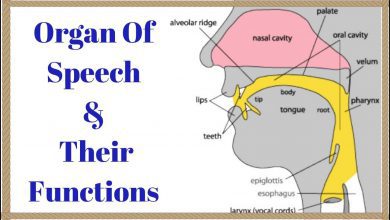Main branches of Phonetics
Main branches of Phonetics
Phonetics is subdivided into four main branches. Articulatory phonetics is concerned with the study of sounds as the result of the activities of speech organs. It deals with our voice-producing mechanism and the way we produce sounds and prosodic phenomena. It studies respiration, phonation (voice-production), articulation and also the mental processes necessary for the mastery of phonetic system.
Articulatory phonetics
Three kinds of organs are involved in the production of articulated sound: the breathing organs (lungs, bronchi, trachea), the phonation organs (vocal cords, larynx, resonators), and articulation organs (tongue, palate, lips, teeth and glottis).
The air passes from the lungs to the bronchi and then to the trachea, in whose upper part the larynx is located. In the larynx, the vocal cords are located, two flexible muscles that vibrate with the passage of breathing time. If the vocal cords approach and vibrate, sound sounds are produced. On the contrary, if the vocal cords do not vibrate and let the air pass freely, deaf sounds are produced.
Sound articulation is known to the specific placement of the mouth organs (lips, tongue, palate, palate veil, teeth, alveoli, and hard palate) at the time the sound is produced. Due to the mobility of two of the organs of the oral cavity, the tongue and the lips, it is in it that most of the sounds originate. Branches of phonetics
Acoustic phonetics
Area of phonetics dedicated to the acoustic properties of speech sounds, analyzing the type of sound waves that compose it, their production and propagation, the filters that modify it, the resonators that amplify it, etc. Acoustic phonetics uses instruments to analyze and observe the physical characteristics of sounds, an analysis that can currently be performed by computational tools for analyzing speech signals. This field of phonetics studies physical properties such as durations, types of formant frequencies, tone, the intensity with which sounds are produced, wave amplitude and energy.
Based on the description of the different organs involved in the phonation process, a classification of sounds can be established, such as:
- Vocal / non-vowel sound, if the air does not encounter obstacles at its exit.
- Consonant / non-consonant sound, if the air encounters obstacles in its exit.
- Sound sound, if the vocal cords vibrate.
- Dull sound, if the vocal cords do not vibrate.
- Nasal sound, if air exits through the nasal passage.
- Oral sound, if the air leaves the oral cavity.
- Compact / diffuse sound
- Interrupt / continuous sound
- Serious / acute sound
Auditory phonetics
Area of phonetics dedicated to the study of the processes of hearing human speech and the processing of its characteristics by the human brain. It also studies the anatomy and physiology of the human ear, the way sound waves are received and how they are carried by neurons to the brain, where they are finally processed and recognized.
Perceptual phonetics is also interested in the “psychological reality” or mental representation of speech sounds, deeply conditioned by the cognitive processes of sound recognition and greatly influenced by the cerebral representations of sounds through writing. In other words, the number of Portuguese sounds recognized by a foreign speaker will be different from the number of sounds recognized by a native Portuguese. In any case, the phonetic reality is much superior, since we never produce an exactly the same sound, as the computational acoustic analysis proves.

